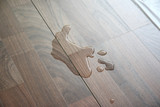Four Waterproof Flooring Terms that You Need to Know

We get this kind of question a lot: "How can a plank floor really be waterproof? Won't a flood of water eventually get through the seams to my subfloor?"
Yes. It absolutely can. There is no floor covering - laminate, vinyl, hardwood, cork - none we can think of that will keep water from getting to your subfloor if there is a flood, or if a big spill is unattended for too long or water seeps up through a concrete subfloor. So what do we mean by these terms? Is it just a big bait-and-switch? No, there may be some difficult to avoid confusion, but we really are saying what we mean. Let me try to clear up these seeming equivocations.
Two Things Our Floors Can Be
Waterproof
What does this mean? It means that the flooring itself, the planks or tiles, are impervious to damage from water and humidity. A steam room, a big spill, even a full on flood that badly damages your home will not hurt these planks. If you have a flood, you have a mess, but once that mess has been taken care of, you will still have this floor to put right back down. That is not likely to happen with laminate, hardwood, bamboo and carpet, to be sure. Most floors do not handle standing water water well, and almost none can withstand a flood. As of press time, we have two 100% waterproof floors that will do both, our click-together and loose lay vinyl plank products.
What doesn't this mean? It does not mean that these floors can be installed outside (see below). It also does not mean that your house or subfloor has been waterproofed, as if a big, single piece of plastic has been applied sealing off your concrete or wood subfloor. We would love that, but it hasn't been made yet (in a plank form).
Water Resistant
Usually this feature is listed for Laminate Flooring, and in flooring it means that the plank is designed to keep any spilled water up on the surface for as long as possible, so you can clean it up without any lasting damage. This is because the exposed part of laminate is in between the planks, where they join together. It's hard for a manufacturer to make an exact time claim, like "For a full 15 minutes!" but they are developing pretty amazing technologies to keep standing water from seeping between the planks and getting under, or into the material of, your flooring.
Things like waxed edges and a sealant called Click Guard aid in keeping the humidity and water at bay.
What doesn't this mean? 'Waterproof'. As well as they resist, there are no 100% waterproof laminate floors. The central 'core' of a laminate floor cannot yet be made impervious to H2O, and if a room floods, the laminate is very likely to become unusable.
It's an important distinction. Waterproof is a big word. There is no wiggle room with that word. For the floor that says this word, it means "Water won't affect me - at all. Full stop." To illustrate this we did an Aquarium Test, putting a few different pieces of flooring in an aquarium full of water for three days to show the impact - or lack of one, in the case of our waterproof vinyl. Take a look.
Waterproof flooring can handle a flood. It does not mean that water won't get around or past a waterproof plank. They don't shrinkwrap your subfloor. Having a waterproof floor doesn't mean your entire house will handle the flooding, but once all is cleaned up, your original flooring can just be dried off and put right back in place, rather than thrown away and expensively replaced.
What is water "resistant" flooring then?
Well first, what isn't even at that level? Carpet. Carpet is not water resistant. If you spill something on carpet, the carpet will get wet. Even if it is stain resistant, such that spilled red wine doesn't color the flooring red, it's still going to get wet. If you lifted up that section, the subfloor underneath would be wet as well, and even after some wiping and dabbing, it will take time to progress from fully wet to damp and then to dry.
Water. Being resisted. Heh.
Water resistance in flooring means that the particular element of flooring has been designed to withstand water better than it normally would. Usually this means 'longer'. With hard surfaces, most flooring is designed to be able to have some water on top for a while before it will soak through, giving you time to take care of the spill before it can badly affect the floor. Just about all laminates claim this. The aluminum oxide coating most of them have is pretty much waterproof, but the seams, those tiny gaps between planks? They aren't, so the floor isn't. In those gaps, you usually have exposed core, and as a general rule, exposed wood-stuff will eventually soak in water and expand.
Are there better seams?
The seams in your laminate floors may have a chemical seal, like Click Guard, they may be waxed (another method of preventing water penetration) or they may just be exposed core. When a laminate floor claims to have a water resistant core, it means that core material has been designed to hold off soaking up water that has gotten through the gaps.
But.
It won't hold it off forever. With water resistant floors, you have some time to get to a spill, but you definitely need to get to it.
And water resistant flooring cannot handle flooding, say from a broken water pipe. Even with a protected seam, if your whole floor is under an inch of water, the resistance element is no longer a factor you can count on, which is why we soaked our pieces for 3 days in the aquarium. You saw the swelling that came about as a result.
How water resistant can these floors get?
Frankly, they can be pretty good, almost annoyingly good. For instance, in a video we made for the Click Guard product we used to sell, we wanted to show how the water seeping into the gaps that didn't use Click Guard would soak into the cores of the planks and, after they dried, cause enough swelling to keep the planks from clicking together properly. Well, we left the water in place for about 6 hours, it did get through the gaps, and it did get to the cores, but frankly, in our case it just didn't do anything to the planks. We had nothing to show you. A "water resistant core" indeed!
Still, when we say water resistant, you really should plan on it not being waterproof, and if waterproof is what you need, then just go with that. We didn't test every product we have in the video, and for some laminates, a spill left unattended for 6 hours really will make your planks swell. We're always going to be conservative in our recommendations, because our goal is for the product you receive to be better than you expected it to be, not worse.
Two Things Our Floors Cannot Be
Water Sealing
No floor covering will completely seal off your subfloor from any and all water or humidity. There is nothing that acts like a full shield, if you will. Some people think that a waterproof floor waterproofs a room, or a house. It cannot do that.
What about sheet vinyl? Water can get around the edges at the walls. It can get around and under. Then you have to pull the floor up to dry the subfloor and prevent mold.
Stone tile? Does water go through stone? Maybe not, but it has grout between every tile or plank. Even if water doesn't eventually soak through the grout - which it can do - the grout can still absorb the water and become a little mold farm.
What about moisture barriers? They aren't called 'water barriers', and if they could be they definitely would be. No, these are designed to prevent moisture, vapor or humidity from going up from a cement subfloor floor into your flooring. They are not designed to prevent water from going the other direction, down into the cement. That's just not a capability of a vapor barrier.
Weather-proof
At Floors To Your Home, we sell interior flooring. It is made to go inside only, generally in environmentally controlled places. None of it is designed to be installed outside. You might think that if something is waterproof, and the outside generally only has rain to throw at you, that our vinyl planks should be fine installed on your deck, but we really don't recommend that. Now, to test the waterproof feature, we set some of our floors out in a storm for a weekend, but it was a deliberately extreme test, but not a demonstration of what you should do with this kind of a floor. (We tested some samples in that aquarium video above, and we also don't recommend putting these there or in your pool.)
Hopefully I've cleared these terms up so you can shop knowing that you'll really get what you think you're getting!
– – – –
David has written and made videos about flooring products and installation since 2011 at Floors To Your Home (.com), where he is also the PPC Manager, a Researcher, a Website & Marketing Strategy Team member, Videographer, Social Strategist, Photographer and all around Resource Jito. In my spare time I shoot and edit video, put together a podcast, explore film history, and mix music (as in ‘play with Beatles multi-tracks’). Connect with
W. David Lichty
Follow Team Floors To Your Home on Facebook

 Brown Tone
Brown Tone
 Unfinished
Unfinished
 Red Tone
Red Tone
 Golden Tone
Golden Tone
 Gray Tone
Gray Tone
 Light Tone
Light Tone
 Medium Tone
Medium Tone
 Dark Tone
Dark Tone
 Brown Tone
Brown Tone
 Red Tone
Red Tone
 Golden Tone
Golden Tone
 Gray Tone
Gray Tone
 Light Tone
Light Tone
 Medium Tone
Medium Tone
 Dark Tone
Dark Tone
 Brown Tone
Brown Tone
 Red Tone
Red Tone
 Golden Tone
Golden Tone
 Gray Tone
Gray Tone
 Light Tone
Light Tone
 Medium Tone
Medium Tone
 Dark Tone
Dark Tone
 Multi Color
Multi Color

